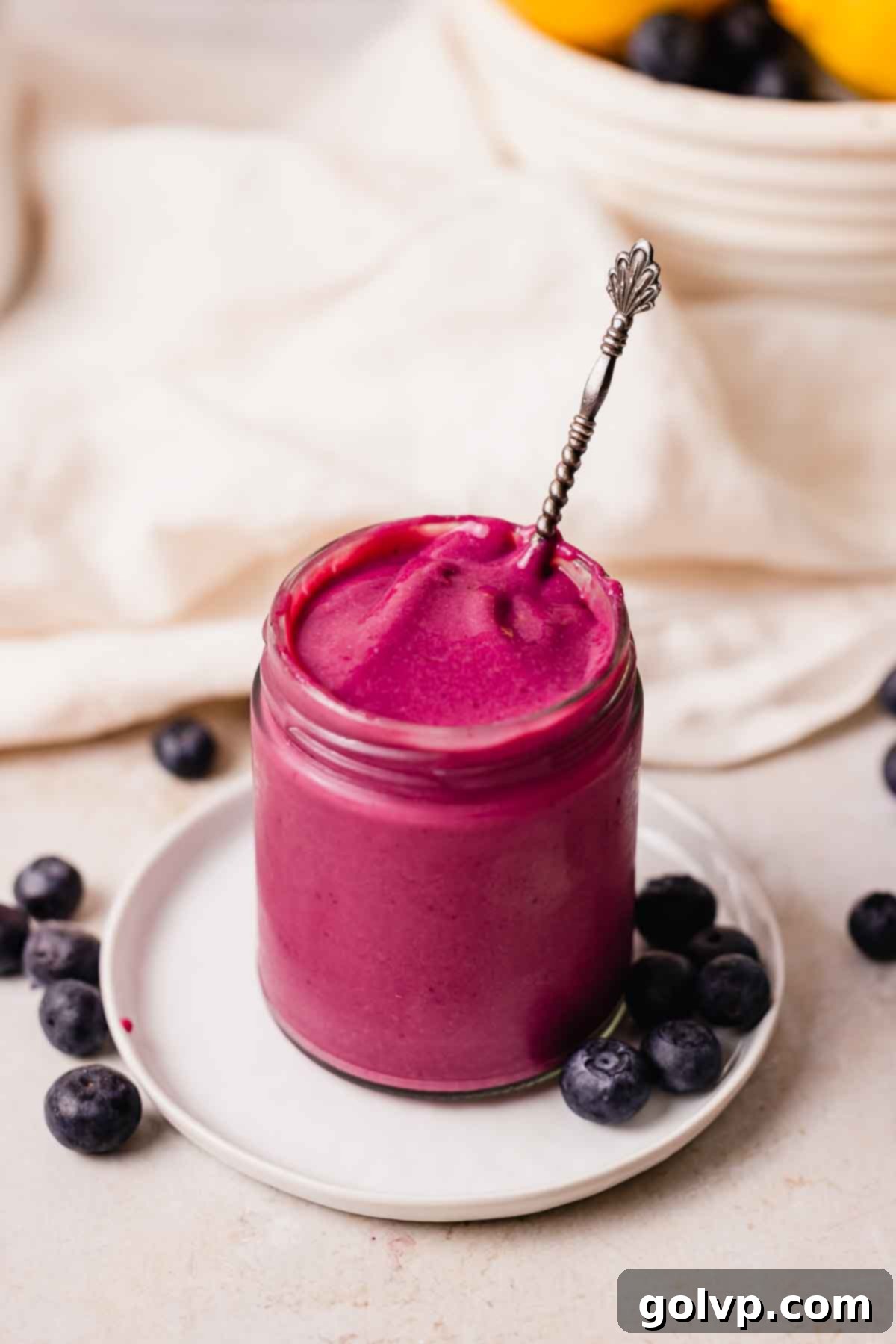Velvety Smooth Blueberry Curd: An Easy Recipe for Bright, Tangy Perfection
Indulge in the vibrant, sweet-tart essence of summer with this incredibly luscious blueberry curd recipe. This isn’t just any spread; it’s a thick, creamy, and gloriously smooth creation, bursting with an intense, bright blueberry flavor that’s both sweet and delightfully tangy. Crafted with just six simple ingredients, this homemade blueberry curd transforms humble berries, eggs, and butter into a luxurious delicacy. Its rich texture makes it an indispensable addition to your culinary repertoire, perfect for enhancing everything from elegant desserts to everyday breakfast delights. Forget store-bought options; once you taste the homemade difference, you’ll be captivated by its fresh, authentic taste and velvety consistency. Use it as a vibrant filling for cakes, tarts, and pies, or simply spread it generously on pancakes, scones, or toast for an elevated morning treat. If you adore classic lemon curd, prepare to fall in love with its berry-infused counterpart. For another delightful berry twist, you’ll also adore our raspberry curd recipe!
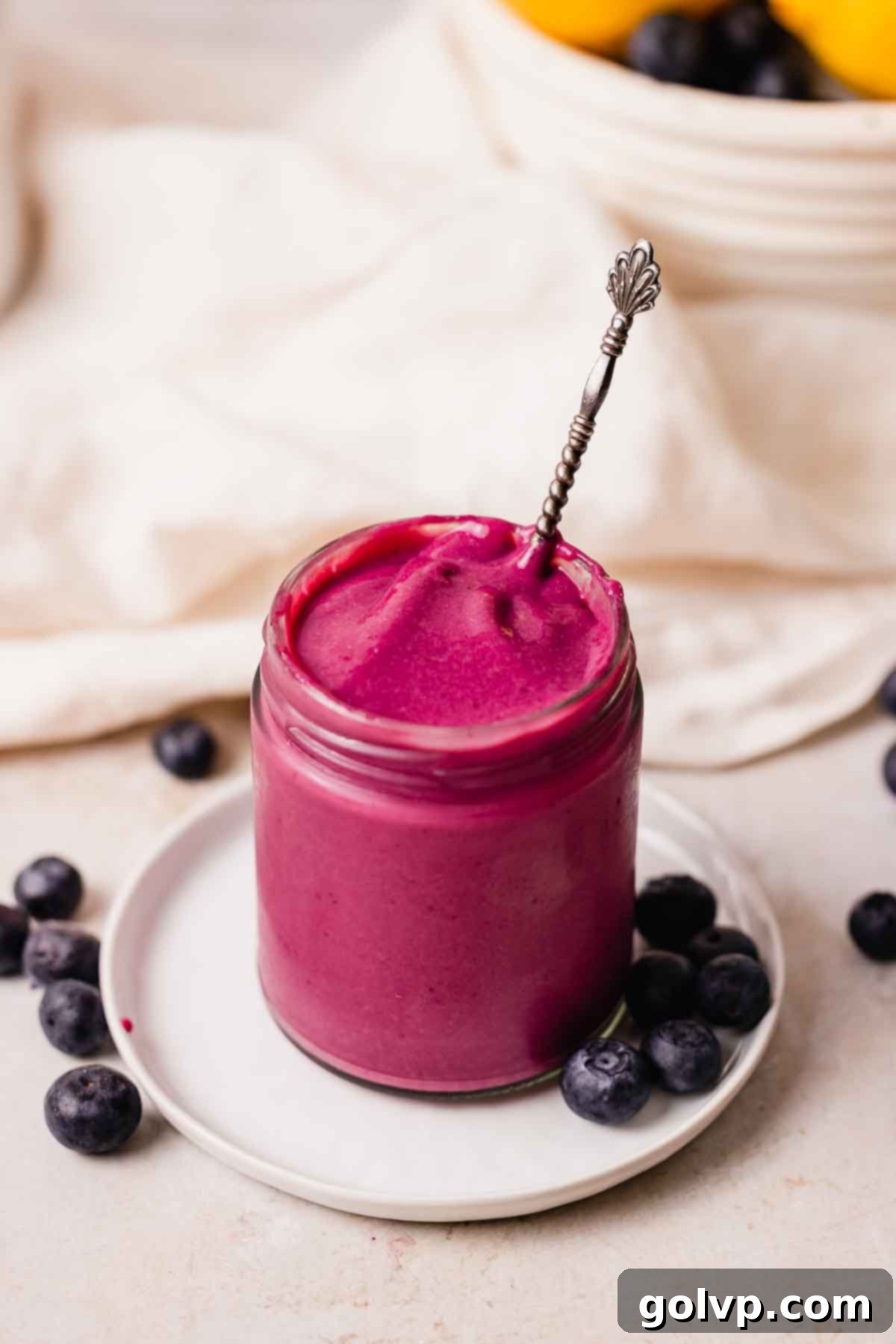
Why You’ll Adore This Homemade Blueberry Curd
There are countless reasons why this blueberry curd will become your new favorite go-to recipe. From its unparalleled flavor to its surprising ease of preparation, every aspect is designed to bring joy to your kitchen and palate.
- Unforgettable Blueberry Flavor: This curd truly captures the essence of fresh blueberries. By specifically calling for wild blueberries, combined with a touch of fresh lemon juice, we achieve an extraordinarily bright, concentrated, and complex berry flavor that far surpasses anything you’ll find in a jar. It’s similar in its delightful tang to lemon curd but with the unmistakable sweetness and fruitiness of blueberries, making it truly unique.
- Perfectly Thick & Creamy Texture: Prepare for an incredibly luscious, velvety texture that’s thick enough to hold its shape beautifully, yet smooth and melt-in-your-mouth. We achieve this desirable consistency using only whole eggs, which contribute to the curd’s body and richness without the need for additional starches (unless you prefer an extra-firm pie filling). This method results in a truly luxurious spread that feels decadent with every spoonful.
- Remarkably Easy to Make: Don’t be intimidated by the idea of making curd from scratch! This recipe simplifies the process dramatically. It’s as straightforward as combining the ingredients in a single saucepan, gently simmering them until thickened, and then straining for ultimate smoothness. Minimal effort for maximum reward!
- Brilliant Sweet-Tart Balance: The addition of fresh lemon juice is key to elevating the blueberry flavor. It provides a crucial tangy counterpoint to the sweetness of the berries and sugar, preventing the curd from being overly saccharine. This bright acidity highlights the natural fruit notes, creating a perfectly balanced flavor profile that keeps you coming back for more.
If you enjoy this recipe, be sure to explore our equally delightful raspberry curd and classic lemon curd recipes!
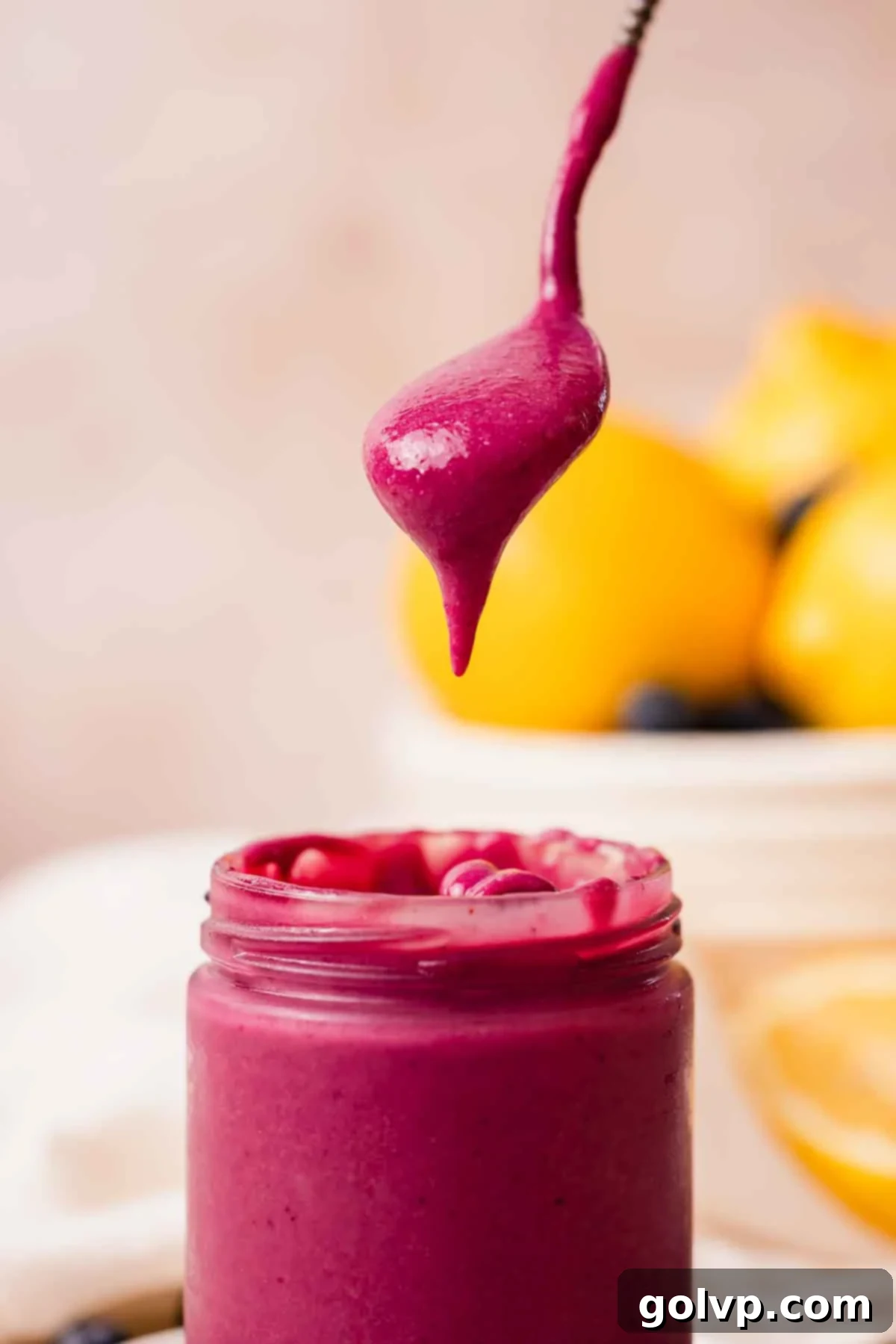
Essential Ingredients for Blueberry Curd
Mastering this recipe starts with understanding the role of each key ingredient. Follow these tips for the best possible results!
For complete steps and precise measurements, please refer to the recipe card below.
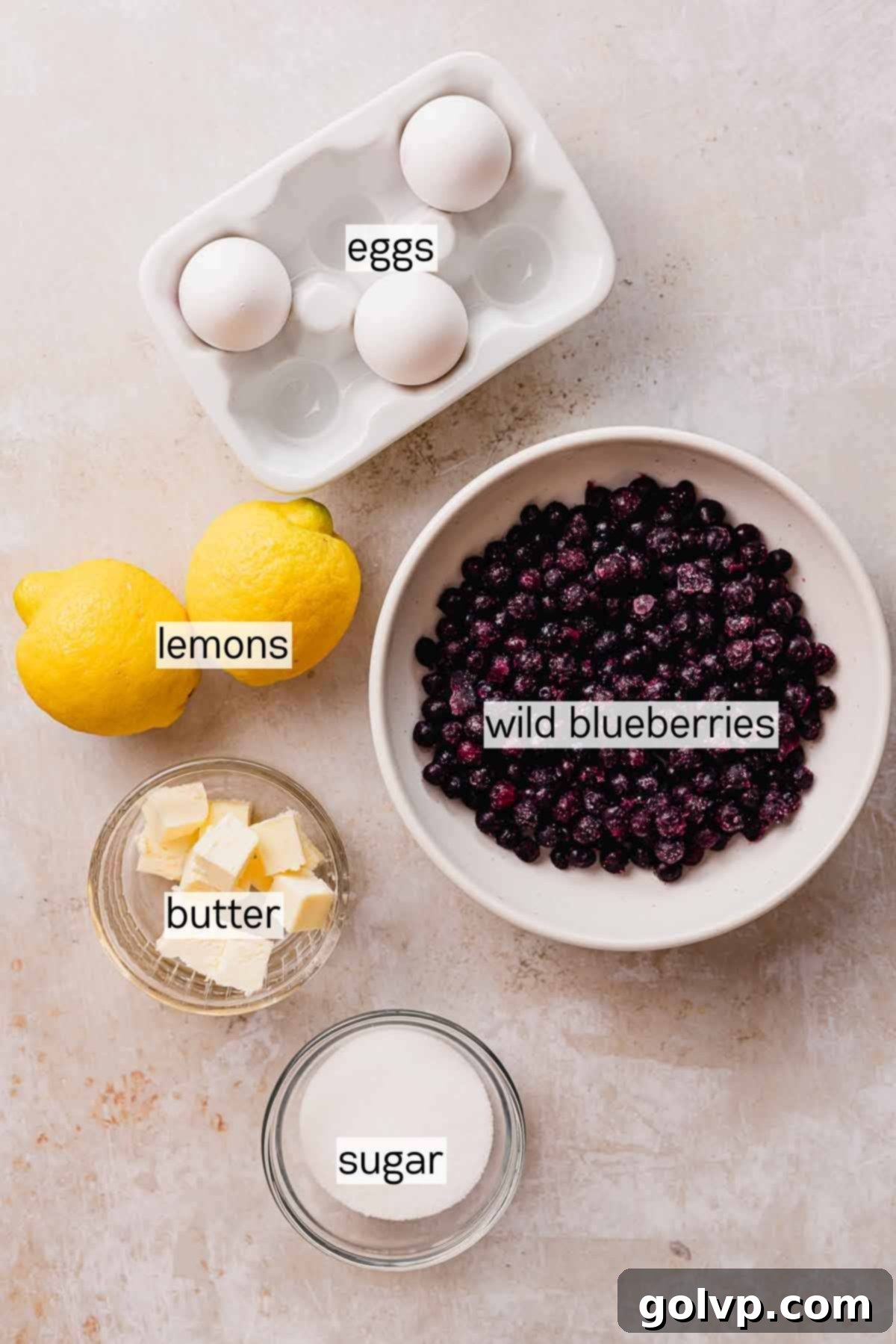
- Whole Eggs: Three whole large eggs are fundamental to achieving the desired thick, creamy consistency of our curd. Eggs act as a natural emulsifier and thickener, creating that luxurious, smooth texture. Critically, using whole eggs (rather than just yolks) is essential for maintaining the vibrant purple hue of the blueberries. Egg yolks tend to be yellow, and too many can dull the natural berry color, shifting it towards a brownish shade. Whole eggs provide the perfect balance for thickening and preserving that beautiful, bright color.
- Wild Blueberries: The secret to an intensely flavorful and vividly colored curd lies in using wild blueberries. Whether fresh or frozen, wild blueberries offer a more concentrated flavor, a brighter pigment, and a lower moisture content compared to their cultivated counterparts. This results in a bolder taste and a naturally thicker curd. While regular blueberries can be used, expect a slightly less vibrant color and flavor, and potentially a slightly thinner consistency. If using regular blueberries, consider reducing the quantity by a tablespoon to compensate for their higher water content.
- Fresh Lemon Juice: A ¼ cup of freshly squeezed lemon juice (typically from about 2 lemons) is crucial. The lemon juice doesn’t just add a delightful tang; it also brightens the overall flavor profile, making the blueberry notes pop. For an even more pronounced citrus aroma, you can optionally add grated lemon zest to the mixture, which will infuse the curd with fragrant essential oils.
- Unsalted Butter: This ingredient is vital for adding richness, smoothness, and a silky mouthfeel to the finished curd. Cold, cubed unsalted butter is whisked in at the end, melting into the hot curd to create a beautiful emulsion. Using unsalted butter allows you to control the overall saltiness of the recipe. We highly recommend against using salted butter, as it can make the curd too salty. For a dairy-free version, simply substitute with a high-quality dairy-free unsalted butter.
- Granulated Sugar: Provides the necessary sweetness to balance the tartness of the blueberries and lemon, and also helps with the texture and preservation of the curd.
- Sea Salt: A tiny pinch of sea salt enhances all the other flavors, bringing out the sweetness and tanginess, creating a more well-rounded taste profile.
For more delightful blueberry creations, consider trying these blueberry brownies or blueberry cheesecake cookies.
Crafting Your Homemade Blueberry Curd: A Step-by-Step Guide
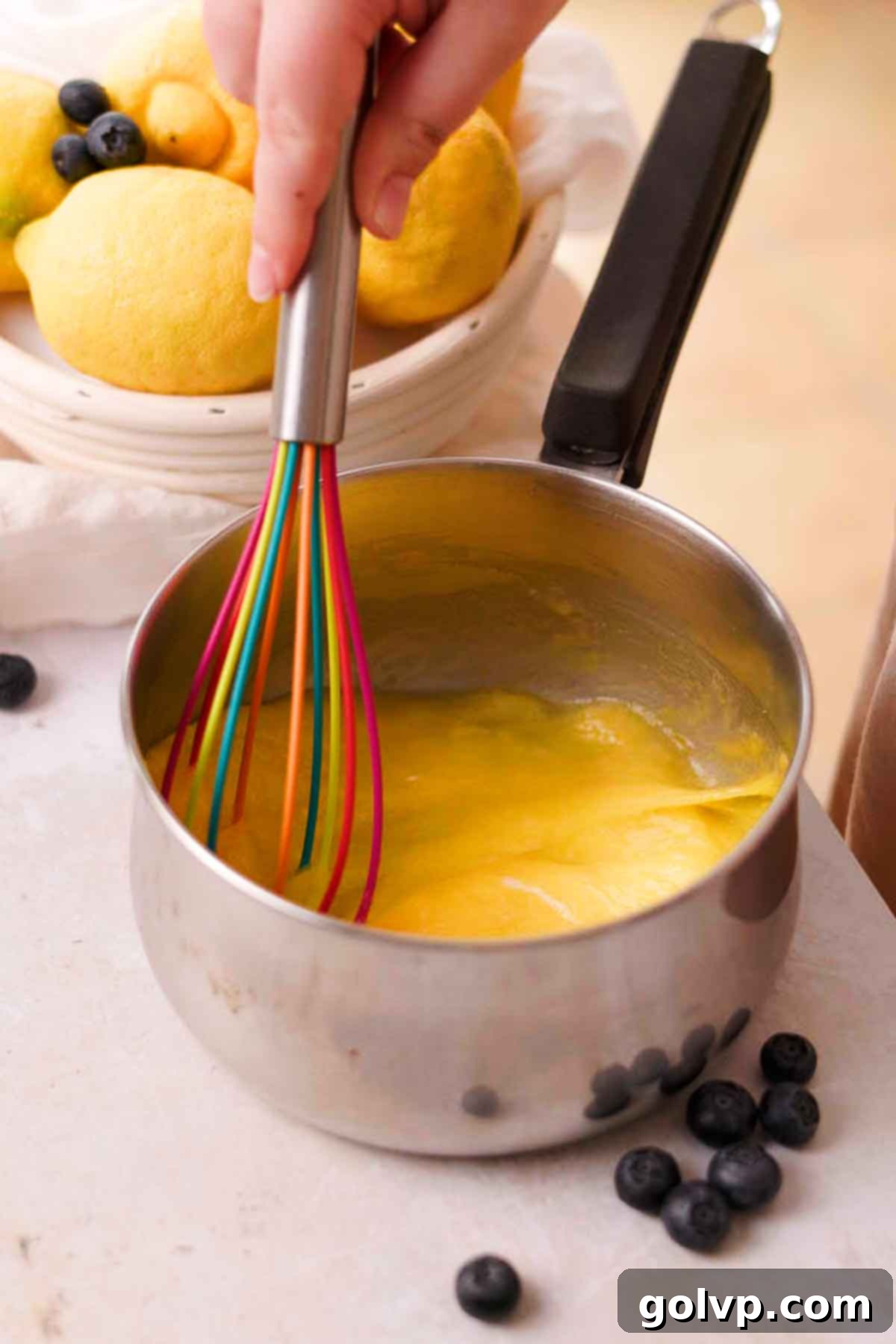
Step 1: Prepare the Base. In a medium-sized, preferably non-metal saucepan (ceramic-coated or stainless steel works best to avoid any metallic aftertaste), combine the granulated sugar, whole eggs, and sea salt. Whisk these ingredients vigorously until the mixture is completely smooth and evenly incorporated. This ensures no lumps form and the sugar dissolves properly.
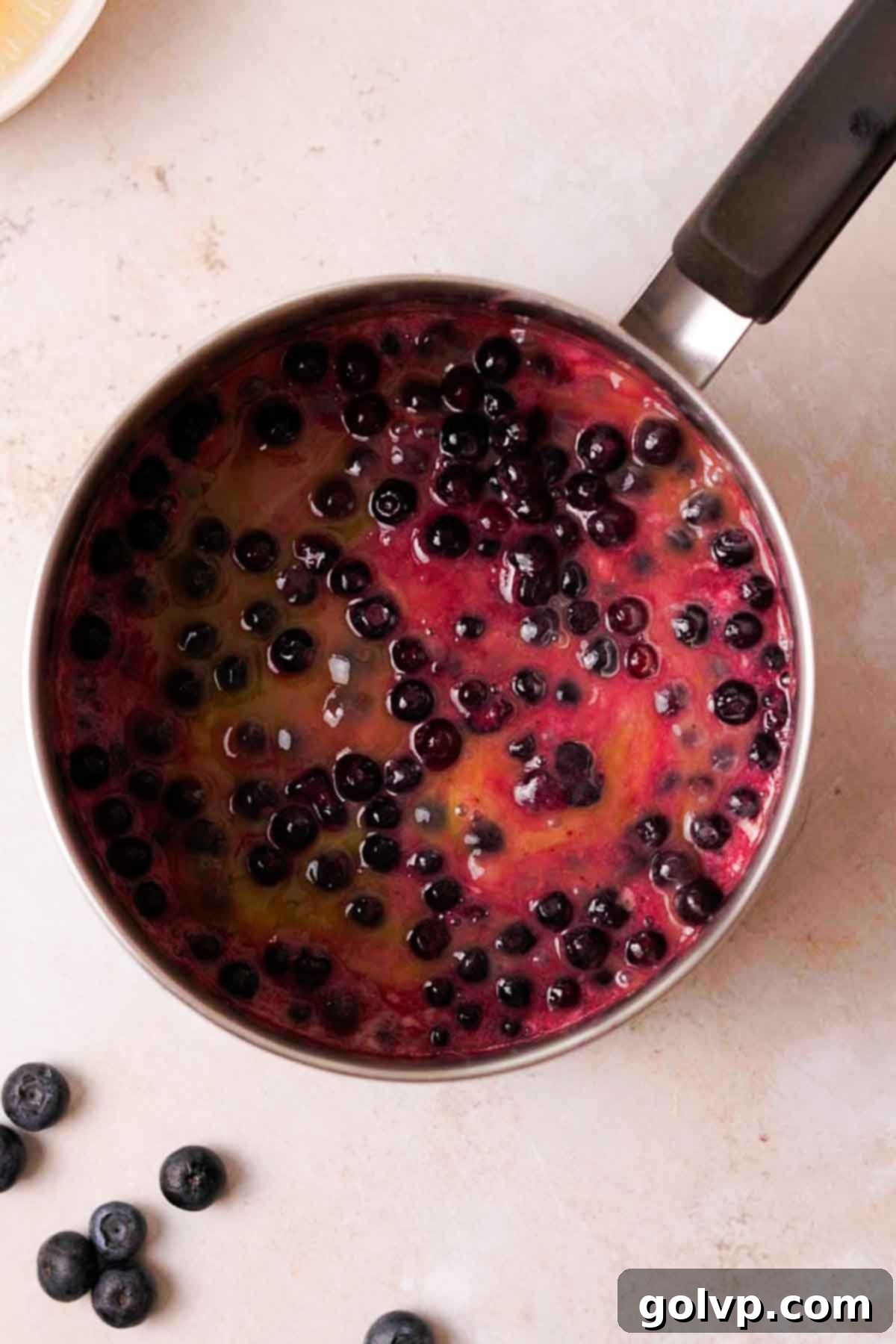
Step 2: Add Fruit and Cook. Introduce the fresh lemon juice and your choice of wild blueberries (fresh or frozen) to the egg mixture in the saucepan. Whisk everything together until well combined. Place the saucepan over medium-low heat. It is crucial to whisk frequently and continuously to prevent the eggs from scrambling and the bottom from scorching. Cook the mixture gently until it begins to simmer and visibly thickens, reaching a consistency similar to a thin custard. Don’t worry if some blueberries remain whole; they will be strained later. The thickening process typically takes about 8-12 minutes.
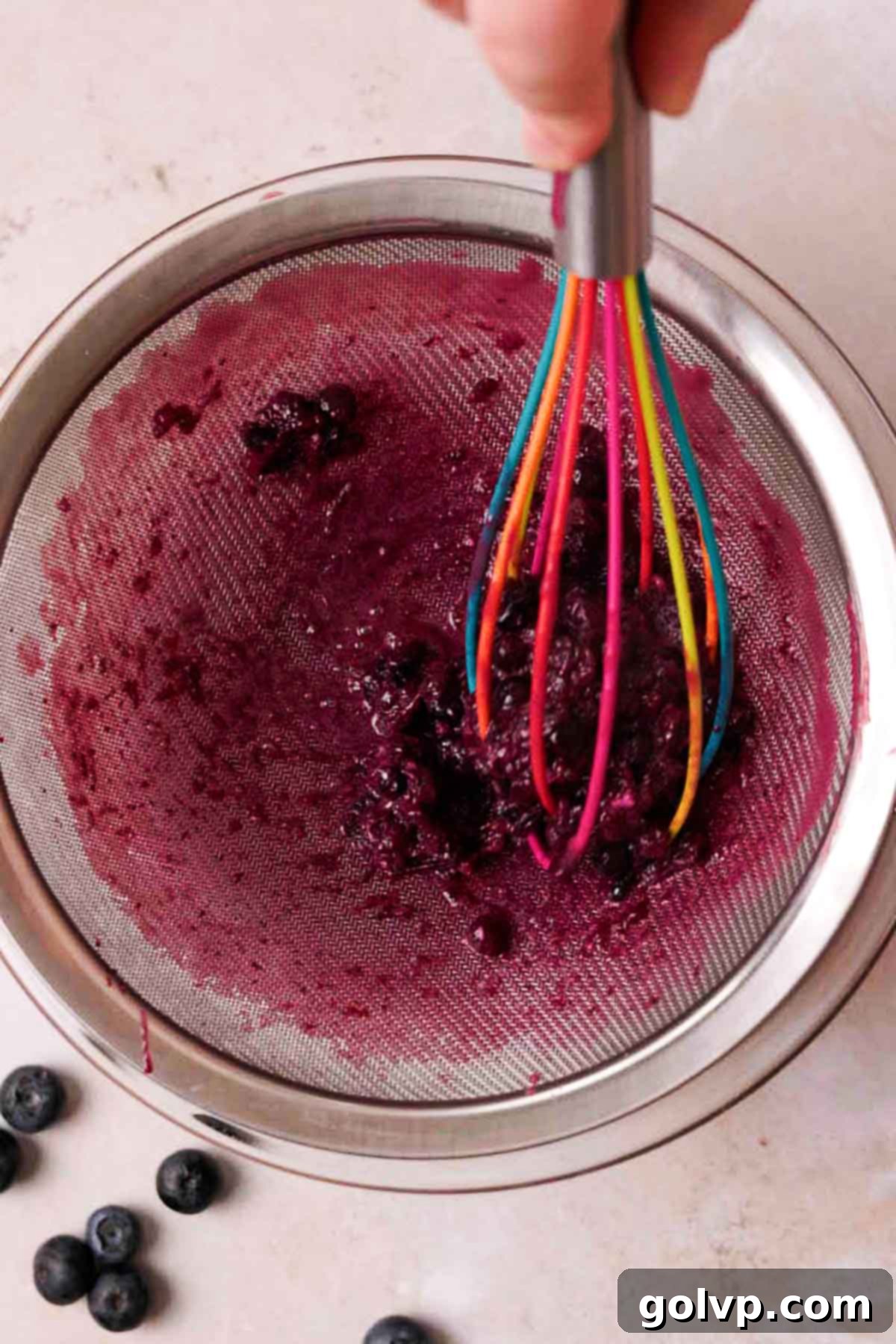
Step 3: Strain for Silkiness. Once thickened, immediately remove the curd from the heat. Carefully strain the hot blueberry curd through a fine-mesh sieve into a clean, heat-safe, non-metal bowl. As you strain, use the back of a spoon or a rubber spatula to press firmly on the blueberries against the sieve. This action helps to extract all their precious juice and flavor, while effectively removing any remaining blueberry skins and seeds, ensuring a perfectly smooth and silky final product.
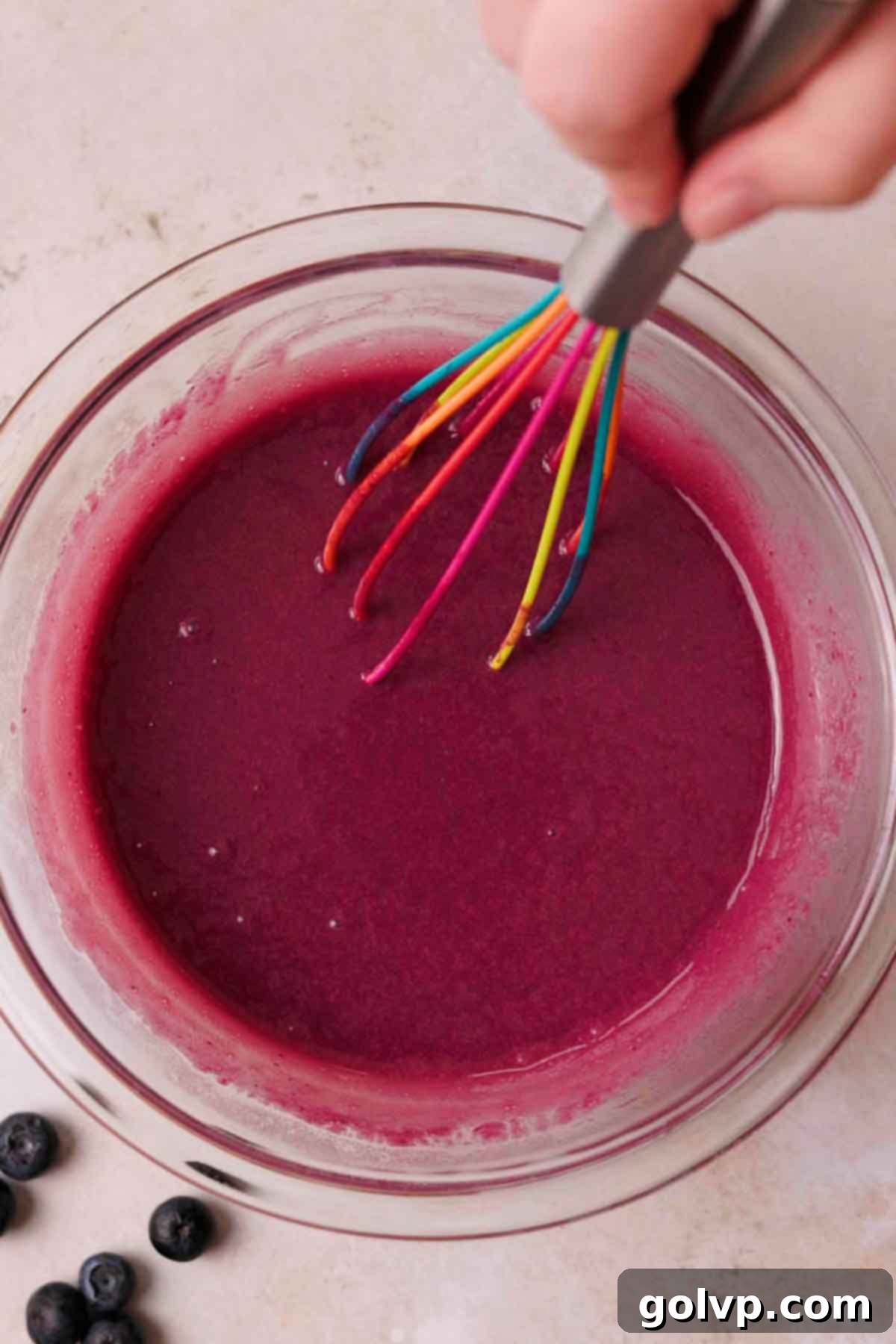
Step 4: Incorporate Butter and Chill. Add the cold, cubed unsalted butter directly into the strained hot curd. Stir continuously until the butter completely melts and is fully incorporated, making the curd even richer and more luxurious. To prevent a “skin” from forming on the surface as it cools, immediately press a piece of parchment paper or plastic wrap directly onto the surface of the hot curd. Refrigerate the curd for at least 1 hour, or until it is thoroughly chilled and has reached its optimal thick, spreadable consistency.
Mastering Curd: Expert Tips for Perfection
Creating perfect fruit curd is an art, but these expert tips will guide you to flawless results every time, ensuring a delicious and vibrant blueberry curd that’s restaurant-quality.
- Choose the Right Cookware: Always use a non-metal or ceramic-coated saucepan for making curd. Metallic pans, especially aluminum or reactive metals, can react with the acidic lemon juice and blueberries, imparting an undesirable metallic flavor or even discoloration to your delicate curd. Ceramic-coated or enamel-coated cast iron pans are ideal.
- Whisk Consistently: The key to a smooth, lump-free curd is constant attention during cooking. Stir the curd frequently, almost continuously, especially when it’s on the heat. This prevents the eggs from setting too quickly at the bottom, which can lead to burning, lumps, or a grainy texture. Gentle, even heat distribution is your friend.
- Don’t Skip Straining: Even if your blueberries seem to break down well during cooking, straining is a non-negotiable step for achieving that signature silky-smooth texture. It removes any lingering blueberry skins, seeds, or tiny bits of cooked egg, ensuring a refined and luxurious mouthfeel.
- Store in Non-Metal Containers: Just as with cooking, storing your finished curd in non-metal containers (like glass jars or bowls) is crucial to prevent any metallic aftertaste from developing over time. Glass mason jars are perfect for both chilling and long-term storage.
- Prevent a Skin from Forming: As curd cools, exposure to air can cause a firm, rubbery skin to form on its surface due to protein coagulation. To avoid this, place a piece of plastic wrap or parchment paper directly onto the surface of the hot curd immediately after straining and butter incorporation. This creates an airtight barrier that keeps the top perfectly smooth.
- Monitor Heat Carefully: Curd should never be brought to a rolling boil. High heat can cause the eggs to curdle, resulting in a grainy texture. Cook over medium-low heat, aiming for a gentle simmer. If you have a thermometer, aim for a temperature between 170-180°F (77-82°C) for optimal thickening.
- Test for Doneness (Nappe Test): To check if your curd is thick enough, dip a spoon into the mixture and then run your finger across the back of the spoon. If the line holds and the curd doesn’t immediately run back together, it’s ready. Remember, it will continue to thicken significantly as it chills in the refrigerator.
Make-Ahead and Storage Guidelines for Blueberry Curd
One of the many beauties of homemade blueberry curd is its excellent shelf life and versatility for advance preparation. This makes it perfect for meal prepping or preparing for special occasions.
Refrigeration: Once prepared and thoroughly chilled, your homemade blueberry curd will keep beautifully in an airtight, non-metal container (such as a glass jar) in the refrigerator for up to one week. Always ensure the container is well-sealed to maintain freshness and prevent absorption of other fridge odors.
Freezing for Longer Storage: For extended enjoyment, blueberry curd freezes exceptionally well. Transfer the cooled curd into an airtight freezer-safe container or a heavy-duty freezer bag, ensuring as much air is removed as possible to prevent freezer burn. It can be frozen for up to 2 months. When you’re ready to use it, simply thaw the frozen curd in the refrigerator overnight. Give it a gentle whisk after thawing to restore its smooth consistency, as it might appear slightly separated initially.
Delightful Serving Suggestions: Beyond the Spoon
This vibrant blueberry curd is so delicious, you might find yourself eating it straight from the jar! However, its versatility extends far beyond a simple spoon. It’s an exquisite spread, a luxurious filling, and a perfect topping for a wide array of sweet treats.
Breakfast & Brunch Enhancements: Elevate your morning routine by pairing this curd with popular breakfast and brunch items. Spread it generously on warm toast, fluffy lemon poppy seed scones, or freshly baked croissants. It’s also sensational spooned over hot blueberry lemon ricotta pancakes, crispy waffles, or delicate crepes. For a lighter option, swirl it into plain yogurt, oatmeal, or layer it in a parfait with granola and fresh berries.
Decadent Dessert Fillings: This blueberry curd shines as a filling for various desserts, adding a burst of fruit flavor and silky texture. It works perfectly as a vibrant filling for a classic layer cake; imagine it nestled between layers of this moist blueberry birthday cake, complemented by a light cream cheese frosting. It’s also an incredible addition to tarts, pies, and cupcakes. You can even create an extraordinary cheesecake by swapping out the lemon curd in this no-bake lemon curd cheesecake recipe for a delightful blueberry twist. The combination of creamy cheesecake and tangy blueberry curd is truly irresistible.
For Pies and Tarts: If you plan to use this blueberry curd as a firm pie or tart filling that needs to hold its shape when sliced, we recommend a slight modification. Before cooking, whisk in 1-2 teaspoons of cornstarch or arrowroot powder with the sugar and eggs. This extra thickener will ensure a more robust set, allowing for clean, beautiful slices without compromising the flavor.
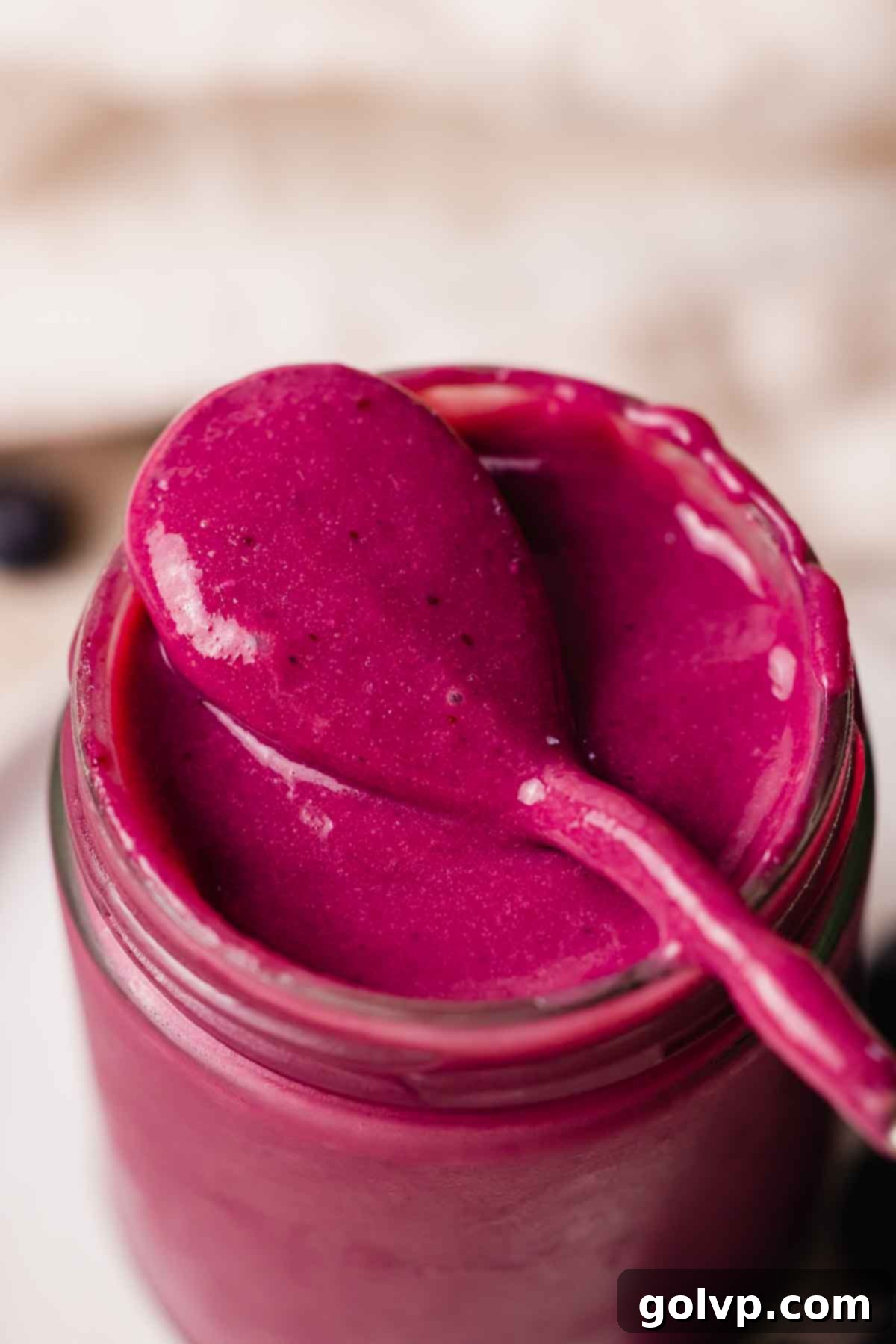
Achieving a Stunning, Vibrant Berry Curd Color
One of the most appealing aspects of this blueberry curd is its gorgeous, vivid purple hue. This isn’t just a happy accident; it’s a deliberate choice in the recipe’s design, focusing on the specific interplay of ingredients to maximize the natural beauty of the blueberries.
The secret lies primarily in our use of **whole eggs** instead of solely egg yolks, or a combination of yolks and whole eggs. Egg yolks, by nature, are yellow. When you incorporate too many yellow yolks into a purple berry mixture, the colors can clash and dull. The yellow pigments from the yolks mix with the anthocyanins (the natural purple pigments) from the blueberries, often resulting in a muddy, brownish, or muted purple color rather than the bright, clear purple we desire.
Using whole eggs provides sufficient thickening power while minimizing the yellowing effect. The whites of the eggs contribute to the thickening without adding significant color, allowing the natural vibrancy of the blueberries to truly shine through. This method is the perfect solution for achieving a perfectly thick curd that also boasts a stunning, eye-catching color.
To further enhance this vibrancy, we also recommend selecting eggs with yolks that aren’t excessively deep yellow, if you have a choice. Combined with the naturally richer color of wild blueberries, this approach guarantees a curd that looks as incredible as it tastes.
The Wild Advantage: Why Opt for Wild Blueberries?
While any blueberries will yield a delicious curd, choosing wild blueberries can significantly elevate your homemade creation. There are several compelling reasons why we highly recommend them for this recipe:
- Intensified Flavor: Wild blueberries are known for their more concentrated, complex, and “truer” blueberry flavor compared to their larger, cultivated counterparts. Their smaller size means a higher skin-to-flesh ratio, packing a more potent berry punch into every bite. This results in a curd with a deeper, more pronounced blueberry taste.
- Vibrant Color: As mentioned, wild blueberries typically possess a richer, more intense purple pigment. This translates directly into a more beautiful and vibrant purple curd, especially when paired with our whole-egg technique.
- Lower Moisture Content: Wild blueberries tend to have less water content than regular blueberries. This is beneficial for curd making because less moisture means the curd will naturally thicken more easily and achieve a desirable rich consistency without excessive cooking or additional thickeners.
- Year-Round Accessibility: Perhaps one of the greatest advantages is that frozen wild blueberries are readily available in most grocery stores year-round. This means you don’t have to wait for peak blueberry season to enjoy this delicious curd. Frozen wild blueberries are picked at their prime and flash-frozen, locking in all their flavor and nutrients.
What if you can’t find wild blueberries? No problem! You can absolutely use regular blueberries (fresh or frozen). If using regular blueberries, to achieve a similar thickness to that made with wild blueberries, we recommend slightly reducing the amount by about 1 tablespoon. This small adjustment helps to account for their higher moisture content. You might also notice a slightly milder flavor and a less intense purple color, but the curd will still be incredibly tasty!
Common Questions About Blueberry Curd
Yes, straining is a crucial step for achieving the ultra-smooth, luxurious texture that is characteristic of a high-quality curd. It effectively removes all the blueberry skins and tiny seeds, which can otherwise give the curd a slightly gritty or unpleasant mouthfeel. Furthermore, pressing the berries through the sieve helps to extract every last drop of flavorful juice, ensuring your curd is as rich and intense as possible.
Covering the surface of the hot curd directly with plastic wrap (or parchment paper) is a simple yet vital technique to prevent a “skin” from forming as it cools. Curd contains proteins (from the eggs) that, when exposed to air during cooling, can coagulate and dry out, forming a thick, rubbery layer on top. By pressing the wrap directly onto the surface, you create an airtight barrier, keeping the top perfectly smooth, moist, and free from any undesirable texture. This method is also commonly used for custards and puddings for the same reason. You can remove the wrap once the curd is fully chilled before transferring it to a storage jar or serving.
Absolutely! To make a delicious dairy-free blueberry curd, simply substitute the unsalted butter with an equal amount of high-quality dairy-free unsalted butter. Many excellent plant-based butter alternatives are available today that will yield a wonderfully rich and creamy curd without any dairy. Be sure to choose a brand that you trust for its flavor and melting properties.
The natural thickness of your curd can vary slightly based on factors like the size of your eggs and the juiciness of your specific blueberries. If you desire an even thicker curd beyond what the eggs provide, you can easily enhance its consistency. Simply whisk in 1 to 2 teaspoons of cornstarch or arrowroot powder along with the sugar and eggs at the very beginning of the cooking process. Continue to cook until thickened as directed. For use as a pie filling, where a very firm set is desired for clean slicing, adding this extra thickener (1-2 teaspoons) at the start is highly recommended.
The most common reason for curd not thickening is insufficient cooking time or inadequate heat. It’s essential to let the mixture come to a gentle simmer and continue to cook for at least a minute or two while whisking constantly. The heat activates the proteins in the eggs, causing them to coagulate and thicken the mixture. Ensure you’re cooking over medium-low heat and patiently stirring until it coats the back of a spoon (the “nappe” test). Also, remember that curd will continue to thicken significantly as it cools in the refrigerator, so don’t expect it to be super thick straight off the stove.
Don’t despair if wild blueberries aren’t available! You can certainly use regular cultivated blueberries, whether fresh or frozen. While the flavor might be slightly less intense and the color a touch less vibrant, your curd will still be incredibly delicious. To account for the higher moisture content typically found in regular blueberries, we suggest reducing the amount by 1 tablespoon. This minor adjustment will help maintain a desirable thickness. Simply adjust and enjoy!
Yes, you can use frozen blueberries directly from the freezer. There’s no need to thaw them beforehand. They will naturally break down as the curd heats up, releasing their juices and contributing to the thickening process. In fact, using frozen blueberries can sometimes lead to a slightly thicker curd due to their firmer structure and the burst of juice release during cooking.
Making blueberry curd requires only a few basic kitchen tools. You’ll need a medium non-metal saucepan (ceramic-coated is ideal), a whisk, a fine-mesh sieve for straining, a heat-safe non-metal bowl for the strained curd, and a rubber spatula for pressing the berries. For storage, glass jars or airtight containers are recommended. A kitchen thermometer is optional but helpful for precise temperature control.
More Berry-Inspired and Related Recipes
If you’ve fallen in love with the lusciousness of homemade curd and delightful berry flavors, you’ll be thrilled to explore these other recipes that share similar qualities or make excellent companions to your freshly made blueberry curd. Expand your baking repertoire with these sweet and satisfying treats!
- Blueberry Birthday Cake
- Lemon Curd
- Lemon Curd Cheesecake
- Raspberry Curd
Did you make this recipe? We would be absolutely delighted if you took a moment to rate this recipe and share your thoughts in the comments section below! Your feedback helps us grow and inspires other home bakers. Share your beautiful creation on Instagram and tag @flouringkitchen so we can admire your work. For more delicious recipe ideas and inspiration, be sure to follow us on Pinterest!
📖 Recipe
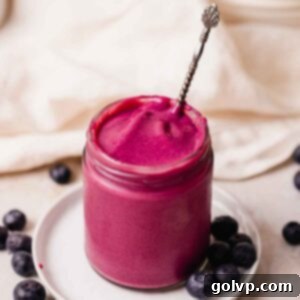
Blueberry Curd
Mary
Pin Recipe
Shop Ingredients
Equipment
-
Medium saucepan use a coated or non-metal saucepan to prevent a metal flavor
-
Fine-mesh sieve for straining
-
Heat-safe non-metal bowl for mixing and chilling
-
Whisk or rubber spatula
Ingredients
- ⅓ cup granulated sugar
- 3 large eggs
- ⅛ teaspoon sea salt
- ¼ cup lemon juice freshly squeezed
- 1 cup blueberries frozen wild blueberries
- ¼ cup unsalted butter cold and cubed
Shop Ingredients on Jupiter
Instructions
-
In a medium saucepan (preferably non-metal like ceramic-coated to prevent a metallic flavor), combine the granulated sugar, eggs, and salt. Whisk thoroughly until the mixture is smooth and well combined.⅓ cup granulated sugar, 3 large eggs, ⅛ teaspoon sea salt
-
Add the lemon juice and blueberries to the saucepan, whisking again to fully combine all ingredients.¼ cup lemon juice, 1 cup blueberries
-
Place the saucepan over medium-low heat. Cook the mixture, whisking frequently and continuously, to prevent burning or scrambling of the eggs. Continue cooking until the curd begins to gently simmer and noticeably thickens to a thin custard-like consistency. It’s perfectly fine if the blueberries do not completely break down at this stage.
-
Immediately strain the hot blueberry curd through a fine-mesh sieve into a clean, heat-safe non-metal bowl. Use the back of a spoon or a spatula to press down on the blueberries, extracting as much juice and flavor as possible. Discard the remaining blueberry skins and seeds to ensure a perfectly smooth curd.
-
Add the cold, cubed unsalted butter into the strained hot curd. Stir until the butter is completely melted and smoothly incorporated. To prevent a skin from forming, cover the surface of the curd directly with a piece of parchment paper or plastic wrap. Refrigerate until thoroughly chilled and thickened, which will take at least 1 hour.¼ cup unsalted butter
-
Your luxurious blueberry curd is now ready to use! Enjoy it as you would any fruit curd or blueberry sauce. Store any leftovers in an airtight non-metal container or jar in the refrigerator for up to one week.
Video
Notes
Expert Tips for Perfect Curd:
- Always use a non-metal or ceramic-coated saucepan to prevent any metallic flavor transfer to the curd.
- Stir the curd frequently and continuously while cooking over medium-low heat to ensure even thickening and prevent burning or lumps.
- Straining the cooked curd through a fine-mesh sieve is essential for achieving an incredibly smooth and silky texture, removing all skins and seeds.
- Store your finished curd in a non-metal container, such as a glass bowl or mason jar, to maintain its pure flavor and vibrant color.
- To prevent a ‘skin’ from forming on the surface as the curd cools, press a piece of plastic wrap or parchment paper directly onto the surface of the hot curd.
- For a thicker curd (especially if using as a pie filling), consider whisking in 1-2 teaspoons of cornstarch or arrowroot powder with the sugar and eggs at the start of the cooking process.
